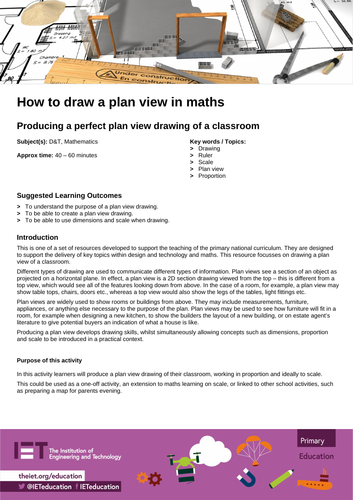


Producing a plan view will help children to develop drawing skills, while also introducing concepts such as dimensions, proportion, and scale. All through our fun, hand-on maths activity!
Different types of drawing are used to communicate different types of information. Plan views see a section of an object as projected on a horizontal plane. In effect, a plan view is a 2D section drawing viewed from the top – this is different from a top view, which would see all of the features looking down from above. In the case of a room, for example, a plan view may show tabletops, chairs, doors etc., whereas a top view would also show the legs of the tables, light fittings etc.
Plan views are widely used to show rooms or buildings from above. They may include measurements, furniture, appliances, or anything else necessary to the purpose of the plan. Plan views may be used to see how furniture will fit in a room, for example when designing a new kitchen, to show the builders the layout of a new building, or on estate agent’s literature to give potential buyers an indication of what a house is like.
The lesson will help learners pick up an understanding of the practical uses of these drawings, from planning the layout of a room to presenting quite complex information about buildings.
This is one of a set of resources developed to support the teaching of the primary national curriculum, particularly key stage two (KS2). It has been designed to support the delivery of key topics within maths and design and technology (DT). This could be used as a one-off activity, an extension to maths learning on scale, or linked to other school activities, such as preparing a map for parents evening.
The engineering context
Designers, engineers, and architects need to be able to communicate the details and features of rooms or products to other engineers, manufacturers, and users. This can include sizes, assembly instructions and layouts. Drawings are typically one of the main methods used for explaining this information – they can be found in every area of engineering and manufacturing.
Suggested learning outcomes
Children will learn about the purpose of a plan view drawing and be able to create one for themselves. They will also learn how to use dimensions and scale when drawing.
Download our activity sheet and related teaching resources
All activity worksheets and supporting resources are free to download, and all the documents are fully editable, so you can tailor them to your students’ and your schools’ needs.
The activity sheet includes teachers’ notes, useful web links, and links (where appropriate) to the national curriculum in each of the four devolved nations; England, Northern Ireland, Scotland and Wales.
And please do share your classroom learning highlights with us @IETeducation.
Something went wrong, please try again later.
This resource hasn't been reviewed yet
To ensure quality for our reviews, only customers who have downloaded this resource can review it
Report this resourceto let us know if it violates our terms and conditions.
Our customer service team will review your report and will be in touch.